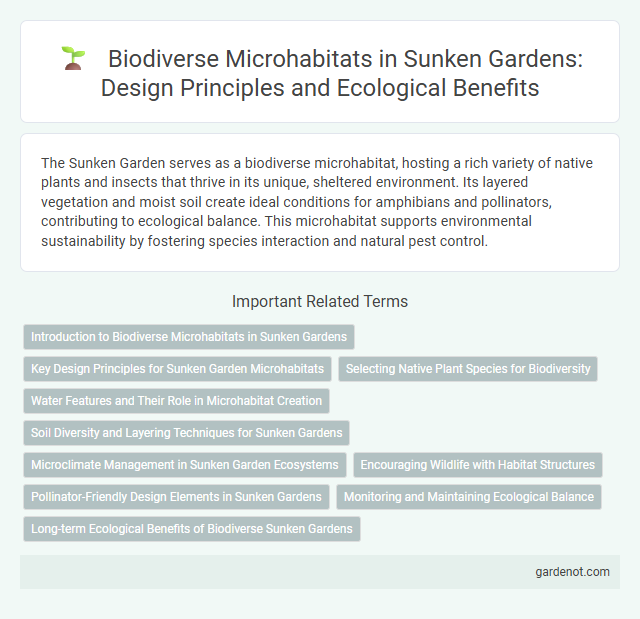The Sunken Garden serves as a biodiverse microhabitat, hosting a rich variety of native plants and insects that thrive in its unique, sheltered environment. Its layered vegetation and moist soil create ideal conditions for amphibians and pollinators, contributing to ecological balance. This microhabitat supports environmental sustainability by fostering species interaction and natural pest control.
Introduction to Biodiverse Microhabitats in Sunken Gardens
Sunken gardens create biodiverse microhabitats by providing varied moisture levels, shade, and soil conditions essential for diverse plant and animal species. These unique environments support a range of flora including ferns, mosses, and shade-loving wildflowers, alongside insects, amphibians, and birds adapted to sheltered, humid conditions. The structural complexity and stable microclimate of sunken gardens enhance ecological richness, promoting sustainable biodiversity within urban and garden settings.
Key Design Principles for Sunken Garden Microhabitats
Sunken garden microhabitats emphasize water retention and soil moisture regulation through strategic excavation and layering techniques. Incorporating native plant species with varying root structures enhances biodiversity and promotes ecological resilience. Design principles prioritize microclimate variation, facilitating diverse habitats for pollinators, amphibians, and beneficial microorganisms within compact spaces.
Selecting Native Plant Species for Biodiversity
Selecting native plant species for a sunken garden enhances the biodiverse microhabitat by providing essential food and shelter for indigenous wildlife. Native plants have evolved to thrive in local soil and climate conditions, supporting pollinators like bees and butterflies while maintaining ecological balance. Prioritizing species such as coneflowers, milkweed, and goldenrod promotes resilience against pests and diseases, ensuring a sustainable and vibrant ecosystem.
Water Features and Their Role in Microhabitat Creation
Water features in a sunken garden create biodiverse microhabitats by supporting aquatic and semi-aquatic species, enhancing ecological variety. These features provide essential hydration, temperature regulation, and breeding grounds for insects, amphibians, and plants, fostering a balanced ecosystem. The presence of standing or flowing water encourages habitat layering, promoting species richness and environmental stability.
Soil Diversity and Layering Techniques for Sunken Gardens
Sunken gardens promote a biodiverse microhabitat by incorporating diverse soil types and layering techniques that enhance nutrient retention and water drainage. Varied soil compositions such as sandy loam, clay, and organic matter create microenvironments supporting different plant species and soil microorganisms. Layering soils with compost, mulch, and mineral-rich substrates improves aeration and moisture balance, fostering a resilient ecosystem ideal for plant growth in sunken garden settings.
Microclimate Management in Sunken Garden Ecosystems
Sunken garden ecosystems create unique biodiverse microhabitats by regulating temperature, humidity, and light exposure through their recessed structure. This microclimate management supports specialized plant and animal species adapted to cooler, moister, and more stable environmental conditions. Effective sunken garden design enhances ecological resilience by promoting biodiversity and mitigating urban heat island effects.
Encouraging Wildlife with Habitat Structures
Sunken gardens create biodiverse microhabitats by incorporating habitat structures such as logs, rocks, and water features that support diverse wildlife species. These elements provide shelter, breeding sites, and foraging opportunities, attracting birds, amphibians, insects, and small mammals. By fostering varied microenvironments, sunken gardens enhance ecological connectivity and promote sustainable urban biodiversity.
Pollinator-Friendly Design Elements in Sunken Gardens
Sunken gardens provide a biodiverse microhabitat by incorporating pollinator-friendly design elements such as native flowering plants, layered vegetation, and continuous bloom cycles, attracting bees, butterflies, and other essential pollinators. Structural features like shallow water sources and sheltered areas enhance habitat suitability, supporting diverse insect populations critical for ecosystem health. These design strategies promote pollination efficiency, plant reproduction, and overall biodiversity within the sunken garden ecosystem.
Monitoring and Maintaining Ecological Balance
Sunken gardens provide a biodiverse microhabitat that supports various native plant and insect species, enhancing local ecological networks. Continuous monitoring using remote sensing and on-site biodiversity surveys helps detect shifts in species composition and habitat health. Maintaining ecological balance relies on adaptive management practices such as invasive species control and soil health optimization to sustain ecosystem functions.
Long-term Ecological Benefits of Biodiverse Sunken Gardens
Sunken gardens create biodiverse microhabitats that support a wide range of plant and animal species, enhancing local ecosystem resilience. These environments promote soil health, water retention, and pollinator activity, leading to sustained ecological balance over time. Long-term, biodiverse sunken gardens contribute to climate regulation, improved air quality, and increased habitat connectivity within urban landscapes.
Biodiverse microhabitat Infographic

 gardenot.com
gardenot.com